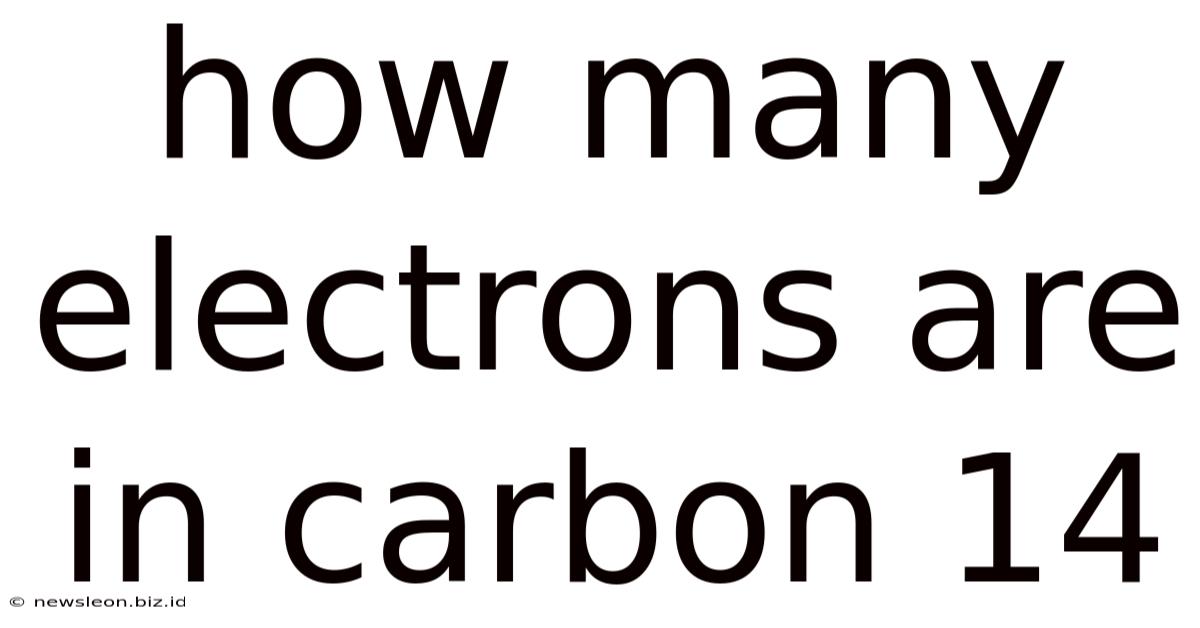How Many Electrons Are In Carbon 14
News Leon
May 05, 2025 · 4 min read

Table of Contents
How Many Electrons Are in Carbon-14? Understanding Isotopes and Electron Configuration
Carbon-14, a fascinating isotope of the ubiquitous element carbon, plays a crucial role in various scientific fields, most notably in radiocarbon dating. Understanding its atomic structure, particularly the number of electrons it possesses, is fundamental to grasping its properties and applications. This comprehensive guide delves into the intricacies of carbon-14, explaining not only the number of electrons but also the underlying principles of atomic structure and isotopic variations.
Understanding Atomic Structure: Protons, Neutrons, and Electrons
Before we delve into the specifics of carbon-14, let's establish a foundational understanding of atomic structure. Every atom consists of three fundamental subatomic particles:
- Protons: Positively charged particles located in the atom's nucleus. The number of protons defines the element; all carbon atoms have six protons.
- Neutrons: Neutral particles (no charge) also residing in the nucleus. The number of neutrons can vary within the same element, leading to isotopes.
- Electrons: Negatively charged particles orbiting the nucleus in electron shells or energy levels. Atoms are electrically neutral; the number of electrons equals the number of protons.
Isotopes: Variations on a Theme
Isotopes are atoms of the same element (same number of protons) that differ in the number of neutrons. This variation in neutron number results in different mass numbers (the sum of protons and neutrons). While isotopes of an element share similar chemical properties, their physical properties can differ, significantly impacting their behavior.
Carbon, for example, has several isotopes, including:
- Carbon-12 (¹²C): The most abundant isotope, possessing six protons and six neutrons.
- Carbon-13 (¹³C): A stable isotope with six protons and seven neutrons.
- Carbon-14 (¹⁴C): A radioactive isotope with six protons and eight neutrons. This is the focus of our discussion.
How Many Electrons in Carbon-14?
Since the number of electrons in a neutral atom always matches the number of protons, and carbon-14 has six protons, carbon-14 has six electrons. The extra neutrons in carbon-14 compared to carbon-12 don't alter the electron count. The electrons are distributed in electron shells according to the principles of electron configuration, ensuring the atom's stability.
Electron Configuration and Orbital Arrangement
The electrons in an atom aren't randomly scattered. They occupy specific energy levels or shells, and within those shells, they populate sub-shells or orbitals. This arrangement dictates the atom's chemical behavior and reactivity.
The electron configuration for carbon-14 (and all carbon isotopes) is: 1s²2s²2p². Let's break this down:
- 1s²: The first energy level (n=1) contains one subshell, the 's' orbital, which can hold up to two electrons. Carbon-14 has two electrons in this orbital.
- 2s²: The second energy level (n=2) also has an 's' orbital, capable of holding two electrons. Carbon-14 fills this orbital as well.
- 2p²: The second energy level also includes 'p' orbitals. There are three 'p' orbitals, each capable of holding two electrons, for a total of six electrons. Carbon-14 has only two electrons populating its 'p' orbitals.
This electron configuration explains carbon's tetravalency – its ability to form four covalent bonds with other atoms. The two unpaired electrons in the 2p orbitals are readily available to participate in chemical bonding.
The Significance of Carbon-14's Radioactivity
Unlike carbon-12 and carbon-13, carbon-14 is radioactive. This radioactivity stems from its unstable nucleus due to the extra neutrons. Carbon-14 undergoes beta decay, transforming a neutron into a proton, an electron, and an antineutrino. This process gradually converts carbon-14 into nitrogen-14.
The half-life of carbon-14 (the time it takes for half of a sample to decay) is approximately 5,730 years. This characteristic makes it an invaluable tool in radiocarbon dating, allowing scientists to determine the age of organic materials up to approximately 50,000 years old. By measuring the remaining ratio of carbon-14 to carbon-12 in a sample, researchers can estimate the time elapsed since the organism died and stopped taking in carbon from the atmosphere.
Carbon-14 in Various Scientific Applications
Beyond radiocarbon dating, carbon-14 finds applications in diverse scientific fields:
- Archaeology: Dating ancient artifacts, human remains, and other organic materials to reconstruct past civilizations and events.
- Geology: Determining the age of geological formations and understanding past climate change.
- Biology: Tracing metabolic processes and studying the movement of carbon in ecosystems.
- Medicine: Used in certain medical imaging techniques and treatments.
Conclusion: Understanding the Atom's Core
Understanding the number of electrons in carbon-14, and its implications within a broader context of atomic structure and isotopes, provides a crucial foundation for comprehending its unique properties and widespread applications. The fact that carbon-14 possesses six electrons, mirroring its six protons, underscores the fundamental principle of electrical neutrality in atoms. This seemingly simple fact is vital in comprehending the intricate processes of radioactive decay, and the powerful dating techniques that allow us to peer into the distant past. The extra neutrons in carbon-14's nucleus, while not affecting the electron count, profoundly influence its stability and radioactive decay, transforming this isotope into a pivotal tool for scientific discovery and understanding our world's history. Its consistent number of electrons, alongside its unique nuclear composition, solidifies its role as a cornerstone in several scientific disciplines, illustrating the interconnectedness of fundamental atomic properties with their practical applications.
Latest Posts
Related Post
Thank you for visiting our website which covers about How Many Electrons Are In Carbon 14 . We hope the information provided has been useful to you. Feel free to contact us if you have any questions or need further assistance. See you next time and don't miss to bookmark.